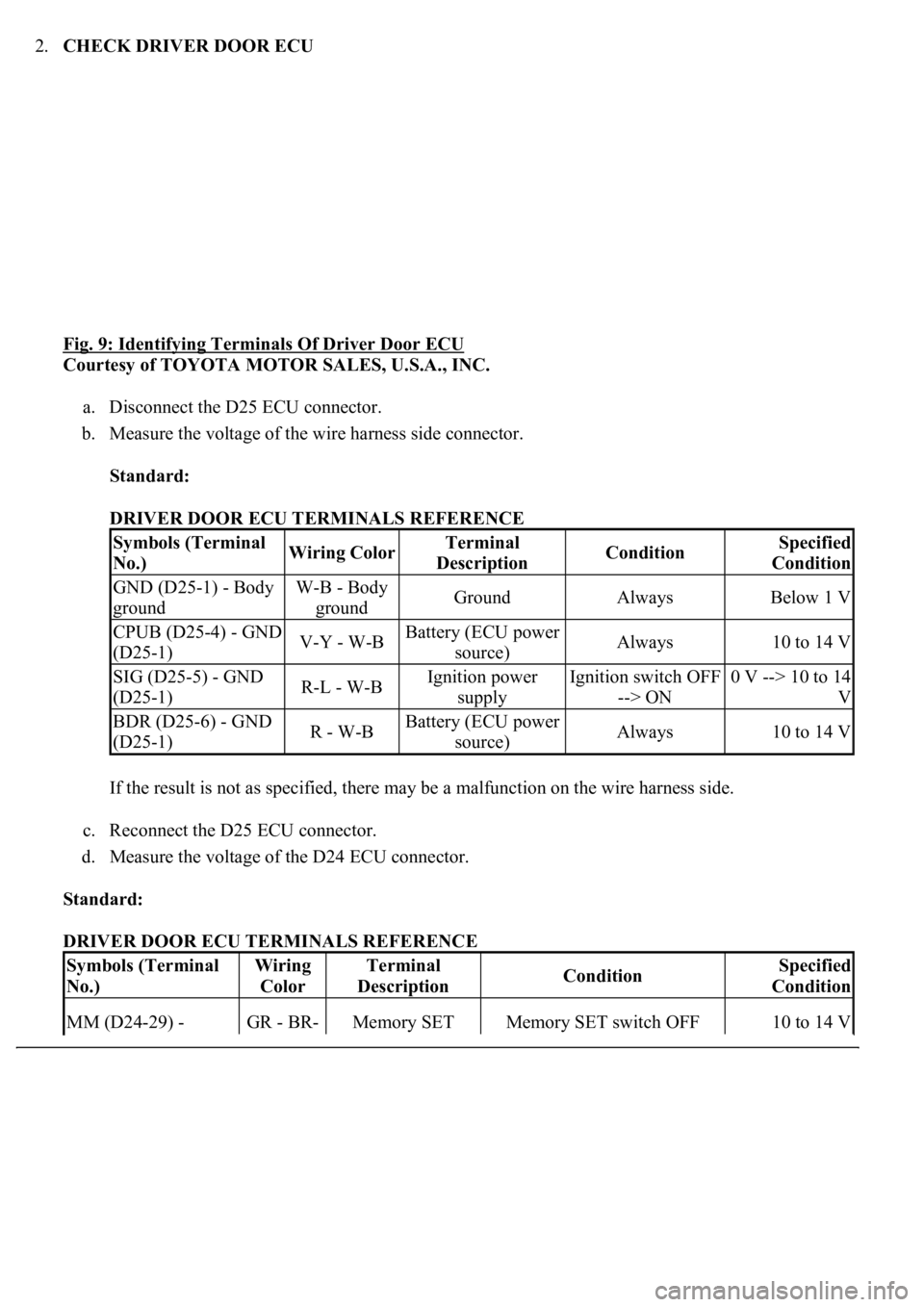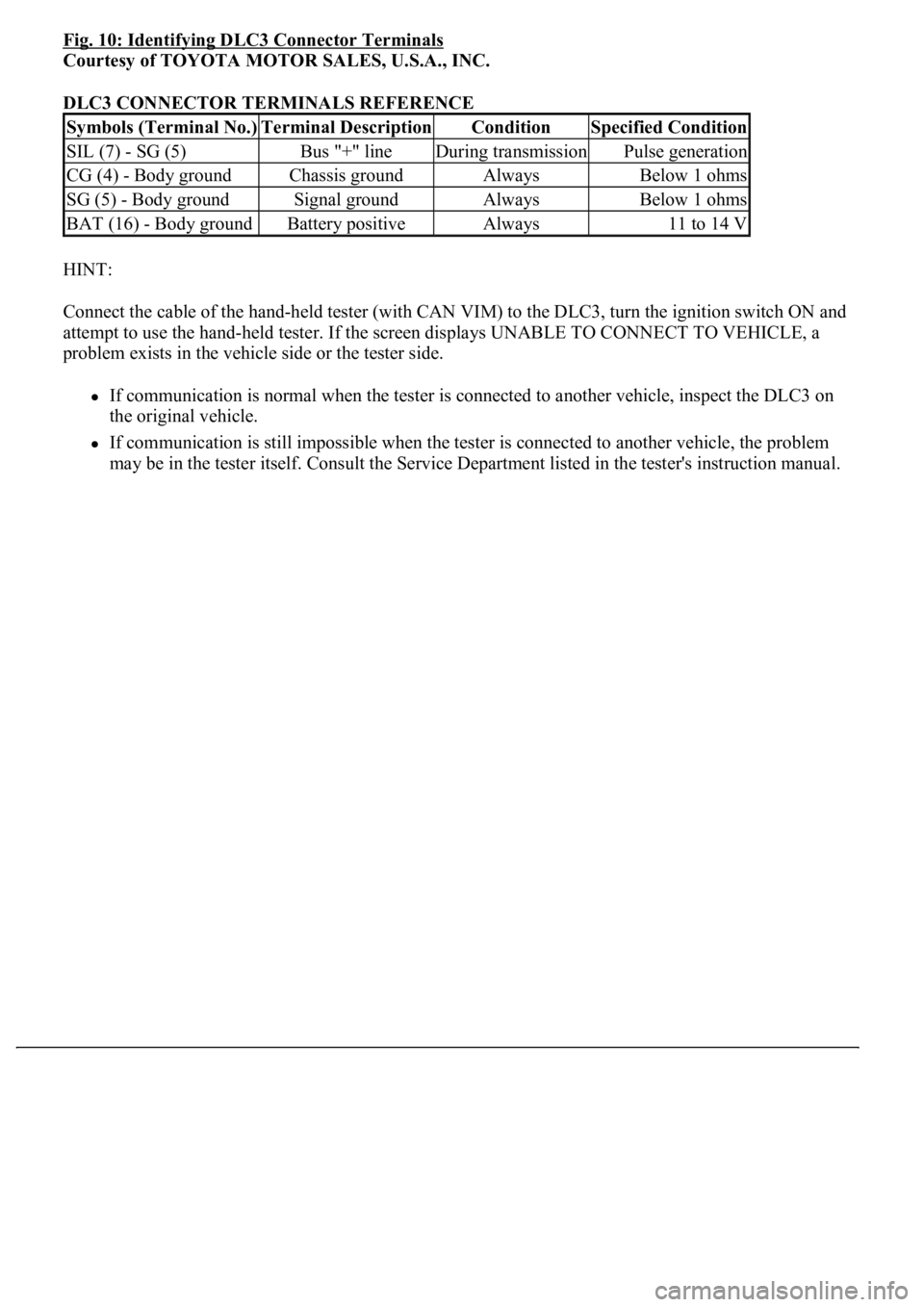Page 3773 of 4500
Fig. 484: Identifying Outside Mark Of Connecting Rod Cap
Courtesy of TOYOTA MOTOR SALES, U.S.A., INC.
c. Install the connecting rod cap bolts.
HINT:
The connecting rod cap bolts are tightened in 2 progressive steps (see steps (2) and (4)).
If any one of the connecting rod cap bolts is broken or deformed, replace it.
1. Apply a light coat of engine oil on the threads and under the heads of the connecting rod cap
bolts.
2. Install and alternately tighten the 2 connecting rod cap bolts in several passes.
Fig. 485: Tightening Connecting Rod Cap Bolts
Courtesy of TOYOTA MOTOR SALES, U.S.A., INC.
Torque: 24.5 N.m (250 kgf.cm, 18 ft.lbf)
If an
y one of the connecting rod cap bolts does not meet the torque specification, replace the
Page 3774 of 4500
connecting rod cap bolts.
3. Mark the front of the connecting cap bolt with paint.
4. Retighten the cap bolts 90° as shown in the illustration.
5. Check that the painted mark is now at a 90° angle to the front.
d. Check that the crankshaft turns smoothly.
e. Check the connecting rod thrust clearance (see step 2).
27.INSTALL WATER SEAL PLATE
a. Remove any old packing (FIPG) material and be careful not to drop any oil on the contact surfaces
of the seal plate and cylinder block.
Fig. 486: Identifying Painted Mark
Courtesy of TOYOTA MOTOR SALES, U.S.A., INC.
Using a razor blade and gasket scraper, remove all the old packing (FIPG) material from the
gasket surfaces and sealing groove.
Thoroughly clean all components to remove all loose material.
Using a non-residue solvent, clean both sealing surfaces.
b. Apply seal packing to the seal plate as shown in the illustration.
Seal packing: Part No. 08826-00080 or equivalent
Page 3881 of 4500
Fig. 92: Identifying Rear Sunshade System Diagram
Courtesy of TOYOTA MOTOR SALES, U.S.A., INC.
ON-VEHICLE INSPECTION
1.BASIC INSPECTION
a. With the ignition switch ON, the shift lever in the P position and the rear sunshade fully open, press
the rear sunshade switch built into the front or rear control switch. Check that the rear sunshade
closes fully.
b. After step (a), press the same switch again and check that the rear sunshade opens fully.
c. With the ignition switch ON, the shift lever in the P position and the rear sunshade fully closed,
move the shift lever into the R (reverse) position. Check that the rear sunshade opens fully.
d. Turn the ignition switch OFF while the rear sunshade is moving up/down. Check that the rear
sunshade stops moving.
e. After step (d), turn the ignition switch ON and press the rear sunshade switch built into the front or
rear control switch. Check that the rear sunshade opens full
y.
Page 3921 of 4500
1.CHECK DRIVER SEAT ECU
Fig. 7: Identifying Terminals Of Driver Seat ECU
Courtesy of TOYOTA MOTOR SALES, U.S.A., INC.
a. Disconnect the D27 and D28 ECU connectors.
b. Measure the voltage of the wire harness side connectors.
Standard:
DRIVER SEAT ECU TERMINALS REFERENCE
If the result is not as specified, there may be a malfunction on the wire harness side.
c. Reconnect the D27 and D28 ECU connectors.
d. Initialize the front power seat (SEE INITIALIZATION
).
e. Measure the voltage of connectors.
Standard:
Symbols (Terminal
No.)Wiring ColorTerminal
DescriptionConditionSpecified
Condition
GND (D27-6) - Body
groundW-B - Body
groundGroundAlwaysBelow 1 V
SGND (D28-1) - Body
groundBR - Body
groundGroundAlwaysBelow 1 V
IG (D28-10) - SGND
(D28-1)R-L - BRIgnition switchIgnition switch OFF
--> ON0 V --> 10 to 14
V
+B (D27-14) - GND
(D27-6)B-R - W-BBatteryAlways10 to 14V
SYSB (D28-9) - SGND
(D28-1)V-Y - BRBatteryAlways10 to 14V
Page 3923 of 4500

2.CHECK DRIVER DOOR ECU
Fig. 9: Identifying Terminals Of Driver Door ECU
Courtesy of TOYOTA MOTOR SALES, U.S.A., INC.
a. Disconnect the D25 ECU connector.
b. Measure the voltage of the wire harness side connector.
Standard:
DRIVER DOOR ECU TERMINALS REFERENCE
If the result is not as specified, there may be a malfunction on the wire harness side.
c. Reconnect the D25 ECU connector.
d. Measure the voltage of the D24 ECU connector.
Standard:
DRIVER DOOR ECU TERMINALS REFERENCE
Symbols (Terminal
No.)Wiring ColorTerminal
DescriptionConditionSpecified
Condition
GND (D25-1) - Body
groundW-B - Body
groundGroundAlwaysBelow 1 V
CPUB (D25-4) - GND
(D25-1)V-Y - W-BBattery (ECU power
source)Always10 to 14 V
SIG (D25-5) - GND
(D25-1)R-L - W-BIgnition power
supplyIgnition switch OFF
--> ON0 V --> 10 to 14
V
BDR (D25-6) - GND
(D25-1)R - W-BBattery (ECU power
source)Always10 to 14 V
Symbols (Terminal
No.)Wiring
ColorTerminal
DescriptionConditionSpecified
Condition
MM (D24-29) - GR - BR-Memory SET Memory SET switch OFF 10 to 14 V
Page 3925 of 4500

Fig. 10: Identifying DLC3 Connector Terminals
Courtesy of TOYOTA MOTOR SALES, U.S.A., INC.
DLC3 CONNECTOR TERMINALS REFERENCE
HINT:
Connect the cable of the hand-held tester (with CAN VIM) to the DLC3, turn the ignition switch ON and
attempt to use the hand-held tester. If the screen displays UNABLE TO CONNECT TO VEHICLE, a
problem exists in the vehicle side or the tester side.
If communication is normal when the tester is connected to another vehicle, inspect the DLC3 on
the original vehicle.
If communication is still impossible when the tester is connected to another vehicle, the problem
may be in the tester itself. Consult the Service Department listed in the tester's instruction manual.
Symbols (Terminal No.)Terminal DescriptionConditionSpecified Condition
SIL (7) - SG (5)Bus "+" lineDuring transmissionPulse generation
CG (4) - Body groundChassis groundAlwaysBelow 1 ohms
SG (5) - Body groundSignal groundAlwaysBelow 1 ohms
BAT (16) - Body groundBattery positiveAlways11 to 14 V
Page 3933 of 4500
Fig. 16: Identifying D-IG1 Relay Terminals
Courtesy of TOYOTA MOTOR SALES, U.S.A., INC.
NG: REPLACE RELAY
OK: GO TO NEXT STEP
3.CHECK WIRE HARNESS (DRIVER SEAT ECU - BATTERY AND BODY GROUND)
a. Disconnect the D27 and D28 ECU connectors.
b. Measure the voltage and resistance of the wire harness side connectors.
Fig. 17: Identifying D27 And D28 Driver Seat ECU Connectors Terminals
Page 3936 of 4500
NG: REPLACE FUSE
OK: GO TO NEXT STEP
2.INSPECT RELAY (D-IG1)
a. Remove the D-IG1 relay from the driver side J/B.
b. Measure the resistance of the relay.
Standard:
TESTER CONNECTION AND SPECIFIED CONDITION
Fig. 19: Identifying D
-IG1 Relay Terminals
Courtesy of TOYOTA MOTOR SALES, U.S.A., INC.
NG: REPLACE RELAY
OK: GO TO NEXT STEP
3.CHECK WIRE HARNESS (DRIVER DOOR ECU - BATTERY AND BODY GROUND)
Tester connectionSpecified condition
3 - 510 kohms or higher
3 - 5Below 1 ohms (when battery voltage is applied to terminals 1 and 2)